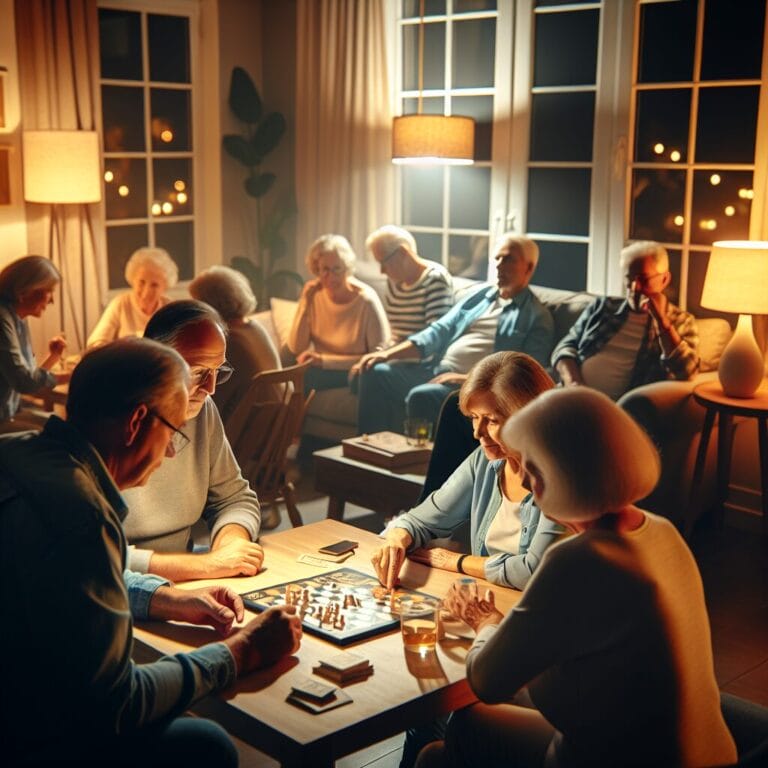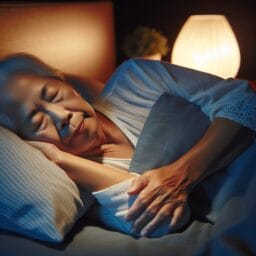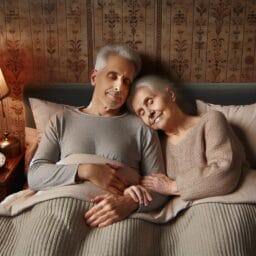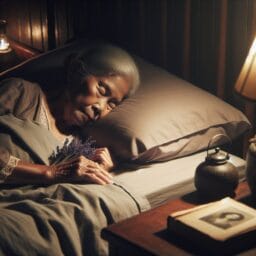
Top Sleep Optimization Tips for the Elderly Leading a Socially Active Lifestyle
Table of Contents
- Introduction
- Understanding Sleep Patterns in the Elderly
- Essential Sleep Optimization Tips
- Balancing Social Activities with Sleep Needs
- Physical Activity and Sleep Quality
- Stress Management Techniques
- Medical Interventions and Consultations
- Technology and Sleep Tracking
- Conclusion
- Frequently Asked Questions
Introduction
Hey there, did you know that as we age, our sleep patterns can do a funny little dance? It’s true! For some older pals, counting sheep for a good night’s sleep gets tougher. But don’t let that wrinkle your forehead. Let’s chat about making snooze-time better for golden-agers who love to stay socially active!
For starters, social butterflies may flutter ’til late and disrupt their homeostatic sleep drive—that fancy inner clock that tells us when it’s time to hit the hay. To keep that clock ticking right, try sticking to a regular bedtime even after a fun day with friends. And here’s a cozy tip: unwinding with a warm bath might just be the magic trick for drifting into dreamland!
Now, if worries are like pesky mosquitoes keeping you awake, cognitive behavioral therapy could swat them away! This non-drug treatment is like having a superhero for your Zzzs; it targets those negative behaviors and thoughts that sneak in when you’re trying to initiate sleep.
And remember those nighttime noshes? Gobbling down refined carbs could make you feel sleepy at first but often lead to a rude awakening later. Instead, whisper sweet nothings to fruits and veggies as a snack—your sleep quality will thank you!
Steering clear of sleeping pills is another smart move because they can leave anyone feeling groggy or confused—which is no fun at all. Turn toward relaxation techniques or maybe some gentle valerian chamomile passionflower tea instead; these have been known to help folks fall asleep fast without the foggy head in the morning.
So there you have it—a handful of cheerful tips to help our elder buddies maintain their zippy social life without sacrificing precious Zzzs. Nighty-night!
| Tip | Description | Benefits |
|---|---|---|
| Regular Bedtime | Stick to a consistent sleep schedule, even after social events. | Helps maintain the homeostatic sleep drive. |
| Warm Bath | Unwind with a warm bath before bed. | Aids in relaxation and can improve sleep onset. |
| Cognitive Behavioral Therapy | Try non-drug treatment to address worries and negative thoughts. | Targets behaviors and thoughts that interfere with sleep. |
| Healthy Snacks | Choose fruits and vegetables over refined carbs for late-night snacks. | Improves sleep quality and prevents sleep disruptions. |
| Avoid Sleeping Pills | Opt for relaxation techniques or herbal teas like valerian, chamomile, or passionflower. | Facilitates falling asleep without next-day grogginess. |
Understanding Sleep Patterns in the Elderly
Did you know that as we grow wiser with age, our sleep architecture—that’s how our snooze is built—changes too? Yep, it gets a bit more delicate and requires some fine-tuning to keep it sturdy. So, let’s dive into the dreamy world of sleep for our cherished older adults.
Now, picture this: You’ve got a sleep castle where the nights are filled with deep slumber and sweet dreams. But as time goes by, this castle might need some extra care. For starters, improving sleep isn’t only about counting sheep. It’s also about understanding that certain disorders like restless leg syndrome or sleep apnea can sneak in and disturb the peace. These uninvited guests can have a not-so-nice impact on health, causing everything from a grumpy mood to trouble remembering things.
Maintaining an active social life is marvelous for mental functioning but juggling it with maintaining sleep can be tricky. It’s like trying to dance without tripping over your own feet! Older patients sometimes find their homeostatic drive—the body’s way of saying “It’s bedtime!”—gets mixed up if they’re out late or if their routine hops around too much.
So what’s an elder to do? Well, here are some quick tips:
– Eliminate alcohol and caffeine before bed – they’re party poopers for your nighttime sleep.
– Develop strategies like using relaxation techniques—a little yoga or meditation can go a long way.
– Create a zen-like sleep environment; think cool, quiet, and comfy.
– Improve those bedtime rituals—reading or listening to soft music could lead you down the path to the Land of Nod faster than you can say “good night.”
Avoid over-the-counter medications that promise instant Zzzs. They might help in the short term but often bring friends like grogginess or confusion along for the ride—not fun at all! Instead, non-drug treatments such as cognitive behavioral therapy pinpoint and shuffle away those negative behaviors crowding around when you’re trying to fall asleep fast.
Here’s another bunch of helpers: Valerian chamomile passionflower blend might just be your cup of tea for a good night’s rest without any next-day fuzziness head. Remember (but just this once), overcoming sleep problems isn’t about doing one big thing; it’s about lots of little steps that together make sure every night is a good night’s sleep!
Essential Sleep Optimization Tips
Did you realize that the very room where older adults doze off can be a secret superhero for superb slumber? That’s right, the bat cave… umm, I mean bedroom needs to be just the perfect hideout for sleep! First thing’s first, let’s set the stage for a sleep-conducive environment. Imagine a peaceful sanctuary where the bed feels like a cloud, and the room whispers “relax” with its cool, dim vibes. Keeping it on the cooler side (around 65 degrees Fahrenheit) and as quiet as a mouse makes your body go “Aha! It’s snooze o’clock!”
But hey, there’s more to this sleep saga than just setting up camp. Let’s talk noms—because what you munch on has a primo effect on those zzzs too. Skip that nightcap and say “no thanks” to late-night caffeine fiestas; they’re real party poopers when it comes to catching winks. Instead, give a high-five to foods rich in magnesium or potassium, like bananas or spinach—they’re like mini tranquility treaties for your body.
Now imagine sipping on some herbal tea magic potion—a blend of valerian chamomile passionflower—that not only tastes like a hug but coaxes you softly into dreamland without any morning fuzzies. Oh, and don’t even peek at over-the-counter medications before hitting the sheets; they sometimes carry extra luggage like grogginess or confusion nobody invited.
Let’s also noodle around with another piece of wizardry: developing strategies that iron out wrinkles in those bedtime rituals. Start by clocking off from screens an hour before bed—trust me, those gadgets are secret sleep-stealers! Then segue into relaxation techniques; maybe some gentle stretches or deep-breathing exercises. Feels good? Yep!
But wait! There’s still one unsung hero in this tale: timing is everything when we’re talking about older patients’ sleep patterns. Try snoozing off slightly earlier each evening—it might seem tiny but can lead to mondo benefits for mental functioning and help maintain that precious homeostatic drive.
When aging affects sleep of older adults, remember (oops!), I mean keep in mind these tips offer more than just modest improvement; they pave the way for feeling sprightly throughout your golden years without daytime sluggishness cramping your style—the recipe for good night’s rest is all here! So here’s to sweeter dreams and sunny mornings after nights spent nestled snugly in your nest of nocturnal bliss!
Balancing Social Activities with Sleep Needs
Did you ever wonder if naps are the secret sidekick for those nights when older adults stay up past their pumpkin time? Well, think of a nap as your trusty power-up—it can swoosh in to save the day after a late-night social shindig. But hold up, before you go all snooze-crazy during the day, let’s chit-chat about how to nap like a pro. Quick catnaps—around 20 minutes—can be just the ticket and won’t mess with your nighttime sleep patterns. It’s like pressing refresh on your brain without having to reboot the whole system!
Say you’ve got an evening bash that’ll keep you rocking past bedtime. Strategy is key! Older patients can still maintain sleep by planning ahead. Consider easing into the party zone by enjoying calmer activities in the early part of the evening—this way, when it’s time to cut loose later, your homeostatic sleep drive doesn’t get too out of whack.
And feast your peepers on this: When aging affects sleep, it’s all about vibe control at night gatherings. Older adults can improve sleep habits by kicking back under softer lighting and turning down those booming tunes as the night wears on; it helps signal to your body that we’re winding down soon.
So here’s what we’ve learned: Improving sleep isn’t just about dodging caffeine or giving sleeping pills the boot (though they’re not great pals with quality Zzzs). It’s also about fitting in those zesty social activities without letting them snatch away good night’s rest. With some nifty nap know-how and smart evening play plans, older folks can enjoy every hootenanny and still wake up feeling ready to bounce into tomorrow!

Physical Activity and Sleep Quality
Rolling out the yoga mat or taking a brisk walk in the park might just be what older adults need for a ticket to dreamland. A sprinkle of regular exercise does wonders for sleep by waving goodbye to stress and anxiety that often play hide-and-seek under the covers at night. It’s like hitting two birds with one stone—pumping up heart health while also nudging those pesky sleep problems out the door.
Let’s circle back to those activities, shall we? Gentle, low-impact exercises such as swimming, tai chi, or even some groovy ballroom dancing can boost both mood and mobility without being too harsh on the joints. And guess what? They’re also social activities that keep older patients grinning from ear to ear throughout their sunny days! Plus, when it comes time to initiate sleep, their bodies are more likely to nod off without a fuss because they’ve been active and happy.
Now don’t go running a marathon right before bedtime; timing is everything. Engaging in these energy-boosting exploits earlier in the day gives your homeostatic drive plenty of time to simmer down so you can drift off faster when night falls. Regular daytime movement means your sleep patterns get into a sweet groove, helping maintain sleep rhythm that keeps cognitive impairment at bay—talk about an all-around win!
To put it simply: Lace-up those sneakers or slip into some comfy walking shoes and let’s get moving! Older adults who shake their tail feathers during the day tend to snuggle up snugly at night for a good night’s rest. It’s not about hardcore workouts; gentle strides lead to leaps in sleep quality. So swirl into your next social activity and know you’re carving the path for serene slumber later—a double dose of joy capped with cozy Zzzs!

Stress Management Techniques
Here’s a little secret that might just be the golden ticket to dreamland for our older buddies: relaxation practices before bedtime can pack a powerful punch in knocking out those pesky sleep problems. Imagine, as the stars twinkle outside, slipping into a pair of cozy pajamas and unwrapping the gift of mindfulness—a present that keeps on giving! By focusing on deep-breathing exercises or dabbling in some gentle meditation moments, elderly folks can escort their minds away from the noise and hustle, leading them down a serene path to fall asleep faster.
But wait—there’s more in this treasure chest of nighttime bliss! A sprinkle of social support can also work wonders. Having friends or family just a phone call away helps lift those heavy worries off one’s shoulders, making space for those feel-sleepy vibes. It’s like having your own cheering squad encouraging you toward that good night’s rest you so deserve.
And let’s not forget the ritual of a warm bath; it’s almost like being wrapped in a hug from your favorite fluffy towel. Combined with some soft tunes or perhaps the soothing scent of lavender wafting through the air, these are not mere details—they’re carriers of sleep magic for improved sleep habits!
So while our silver-haired pals may sometimes find that aging affects sleep patterns more than they’d like, there’s no need to count sheep in despair. With these heartwarming and body-relaxing practices at hand, overcoming sleep problems becomes less about battling insomnia monsters and more about gently guiding oneself to the sweet embrace of slumber—each night promising another chapter in the book of delightful dreams.
Medical Interventions and Consultations
Navigating the snooze cruise can sometimes call for a captain with an MD or PhD after their name, especially when older adults feel more sleepy than a dozing koala during the day. If counting sheep turns into counting the cracks in the ceiling night after night, it may be time to dock at Sleep Clinic Harbor and get some professional guidance. And here’s why: sleep deprivation isn’t just about feeling tired; it can play tug-of-war with mental functioning, yanking hard on that cognitive rope until everything feels a tad fuzzy.
Medications often come aboard as passengers in the journey of overcoming sleep problems—but beware! Some of these traveling companions might overstayed their welcome, causing grogginess and confusion as unwanted souvenirs. Prescription drugs should be cozy comfy helpers, not party crashers making everything worse. It’s like walking a tightrope; sometimes you need them for their expertise in initiating sleep but watch out for adverse effects that could disrupt your peaceful slumber parade.
And let’s shine a spotlight on those behind-the-scenes heroes: sleep studies and assessments. For older patients wrestling with sleep disorders that are sneakier than midnight fridge raiders, these tools are like Sherlock Holmes meets Sandman—detecting hidden clues to improve sleep habits and ensuring every night is a star-studded premiere of “Good Night’s Rest.” So before turning to sleeping pills or counting on a warm bath alone to send you off to dreamland, consider if it’s time for experts to help chart your course through nighttime’s choppy waters toward restful shores.
Technology and Sleep Tracking
Ever wonder if strapping on a wearable sleep tracker could be the snooze scout for older adults? These nifty gadgets are like little sleep detectives, keeping an eye on how well you’re catching those Zzzs. They track everything from how long you snooze to how often you’re tossing and turning, giving you and your doc a clear picture of your nighttime adventures. But here’s the rub: while they can help pinpoint patterns that may need tweaking for better rest, relying too heavily on tech can make some folks anxious—watching numbers instead of focusing on natural sleepiness cues. Plus, not all trackers understand the quirks of elderly sleep rhythms, so it’s key to choose one wisely or seek out apps specifically designed with older patients in mind. They’ll offer tailored tips, like ditching refined carbs before bed or adding valerian chamomile passionflower tea into your evening ritual—all aiming for that sweet spot of good night’s sleep without grogginess or confusion come morning!
Conclusion
Gentle stretches and a cup of chamomile tea might be what grandma and grandpa need to kick sleep troubles out of bed! Older adults often dance with sleep problems as they age, but there are new steps they can take for improving sleep. Let’s talk about a super special non-drug treatment that’s like a secret agent – it targets those negative nighttime thoughts that keep older folks awake. It’s called cognitive behavioral therapy (CBT), and it’s designed to help the brain learn how to fall asleep faster without those pesky over-the-counter medications that can leave you feeling more like a sleepy sloth than bright-eyed bushy-tailed!
Speaking of bright eyes, managing light in the sleep environment is another trick up the pajama sleeve. Dimming lights as evening falls tells your homeostatic drive – that’s your body’s natural clock – that it’s time to wind down. And if social activities have you buzzing late into the night, try this nifty tactic: Relaxation techniques! A few minutes of deep breathing or visualizing a peaceful place can guide older patients gently into dreamland.
So, give these tips a whirl for an improvement in sleep quality, and watch as grogginess or confusion float away like clouds on a sunny day. After all, sweet dreams lead to sunny days – and who doesn’t want to wake up ready to enjoy every golden moment? Embrace these strategies and drift off knowing each snooze gets you closer to waking up with oodles of energy for tomorrow’s adventures!



